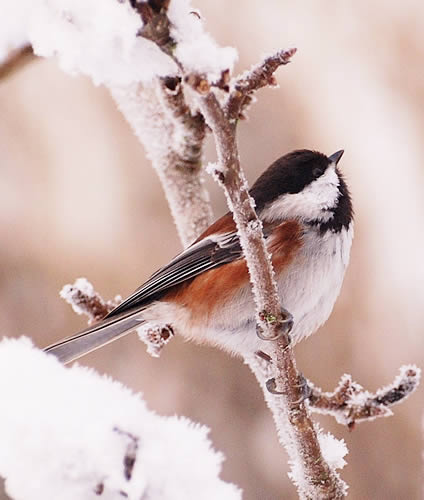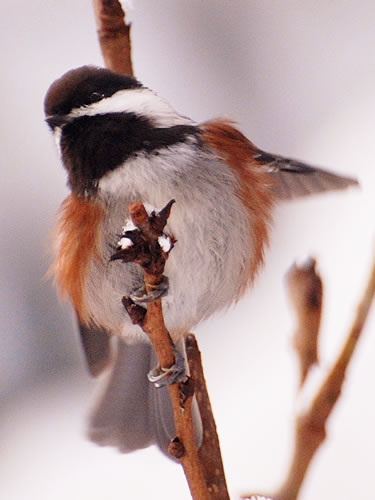With their white cheeks, dark caps and throats, Chestnut-backed Chickadees (poecile rufescens) look similar to Black-capped Chickadees. However the caps of Chestnut-backs are brown rather than black, and their backs, shoulders, and sides are a deep chestnut color. They are also slightly smaller than Black-capped Chickadees. Males, females, and juveniles share similar plumage. These little guys are only about 12 cm long and weigh 10 grams.
Chestnut Backed Chickadees are the only Chickadees found on Vancouver Island and they are the ones we see in the forests and at our feeders here on Gabriola. Chestnut-backed Chickadees favor dense, moist, coniferous forests. They can be found from the lowlands up to the tree line, wherever there is a wet, closed-canopy forest.
During the breeding season Chestnut-backed Chickadees are territorial, but they join mixed-species flocks in winter. They forage by hopping along twigs and branches and gleaning their surfaces or by probing into bark crevices for food. They often hang upside-down to get at the undersides of branches and needles. They readily come to seed and suet feeders. Indeed, if they regularly use a feeder and you get a bit slack and let it become empty, the Chickadees will most likely let you know in no uncertain terms!
Chestnut-backed Chickadees store food in the fall and retrieve it in winter. Insects, spiders, conifer seeds, and berries make up most of these omnivores’ diets. They also readily eat suet and birdseed supplied by humans. Their flight is generally short and undulating, with flock members setting out to cross openings one at a time.
Much of the nesting biology of Chestnut-backed Chickadees is not well known. They are monogamous, and pairs may excavate their own nest cavity (in soft rotten wood) or may use an old woodpecker hole or other cavity, including artificial nest boxes. The female builds a foundation of moss, lichen, and other material within the nest cavity, and then adds a lining of soft hair. She incubates 6 to 7 eggs. Incubation length is not well known, but incubation times for most chickadee species are about two weeks.  Note: I found a website that had an account of a nesting box that was occupied and which had a camera recording the whole nesting event. In this case 8 eggs were laid and 6 chicks eventually fledged (fledging is flying from the nest). It appeared to take about 3 weeks from the first egg laid for all of the eggs to hatch and another 3 weeks until the chicks fledged. The female stayed on the nest most of the time and the male brought food. Occasionally when the male was there, the female would take off for a little break and leave him to feed the kids.
Note: I found a website that had an account of a nesting box that was occupied and which had a camera recording the whole nesting event. In this case 8 eggs were laid and 6 chicks eventually fledged (fledging is flying from the nest). It appeared to take about 3 weeks from the first egg laid for all of the eggs to hatch and another 3 weeks until the chicks fledged. The female stayed on the nest most of the time and the male brought food. Occasionally when the male was there, the female would take off for a little break and leave him to feed the kids.
During some winters Chestnut-backed Chickadees in colder climates may wander short distances, mostly as a result of food shortages. For the most part, however, they are permanent residents – and we are lucky to share our beautiful island with these delightful little birds!
Jean Wyenberg
GROWLS
